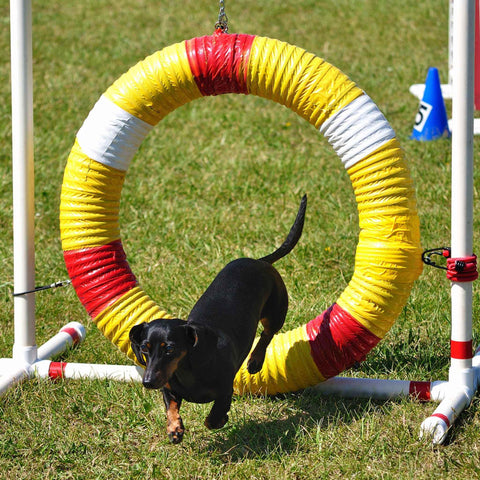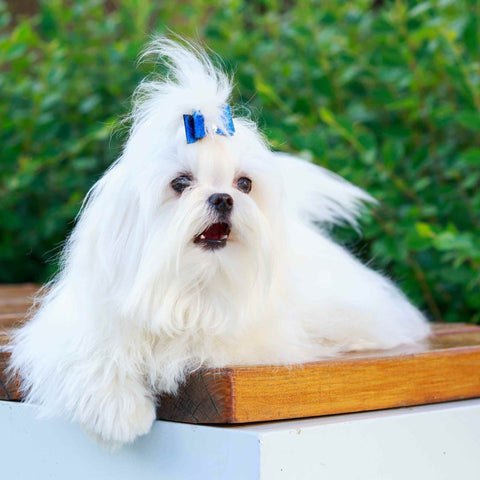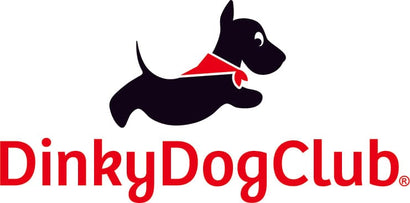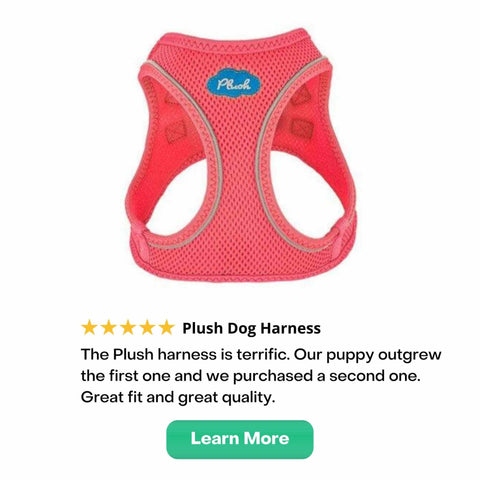
10 New Year Resolutions for Your Small Dog
December 30, 2021 8 min read 0 Comments
New Year resolutions aren’t just for humans. You can set some goals for your small dog to achieve in 2022. From weight loss to becoming a certified therapy dog, here are ten new year resolutions for you and your furry friend to consider.
1. Take more dog walks in 2022.

Both you and your dog will benefit from regular walks. For you, it’s fresh air, exercise and a chance to chat with your neighbors or meet new fellow dog owners. At the other end of the leash, your dog will get some exercise and a chance to smell all of the smells, which provides needed mental stimulation.
If you already take regular walks with your dog, great job! If your dog walks are a little more random, set a goal to walk more often with your dog. Start with two days a week and gradually work your way up to five days a week if you’re both up for it.
Along with regular walks, set a goal to walk somewhere outside your neighborhood at least once a week, such as a nearby park, walking trail or another neighborhood. Both you and your pup will be energized and refreshed by the change of scenery.
If you have an Apple Watch, dog walks are a great way to close your rings.
Need a new harness to kick off your 2022 dog walking goals? Check out the highly rated harnesses below.
2. Help your lose weight.
Just like with humans, an overweight dog has a higher risk of heart disease, diabetes, high blood pressure, liver disease and several other health issues. Extra weight also puts more stress on your little dog's joints.
Thinking about small dogs, an extra 1 pound on a six or seven pound dog is a lot of extra weight. The start of a new year is the perfect time to help your furry friend slim down.
The key to helping your pup trim down is determining the correct amount of food your dog needs per day based on his/her weight, age and activity level. Once you know how much food your dog needs, be disciplined about measuring out the correct amount at each feeding. Using a measuring cup instead of eyeballing how much food goes into the dog bowl ensures you feed the right amount of food every time.
You’ll also want to cut back on table snacks and treats. Also keep an eye on the calories in your pup’s favorite treats. Peanut butter and cheese treats are delicious to so many dogs, but they also tend to be very high in calories.
If you're doing training exercises with your dog, keep that in mind when feeding your dog. Let's say you sign up for agility training and you know on the class night your dog will earn lots of treats for his or her hard work, you'll want to cut back on the amount you feed your dog that particular day.
If you're not confident in your ability to trim your dog's weight, schedule a visit with your veterinarian to come up with a plan to slowly trim your dog down to his or her ideal weight.
3. Teach your small dog new tricks.
Teaching your dog tricks is fun for both you and your dog. You're rewarded by the satisfaction of seeing your training efforts pay off, and showing family and friends how talented your dog is. Most dogs love the one on one attention involved in training sessions and being natural people pleasers, dogs are eager to take on new tasks.
Start with simple tricks like sit, stay, shake, and spin. You’ll be amazed at how quickly dogs can learn and how eager they are to learn something new. Once you get a few easy tricks under your belt, you can move on to more advanced tricks.
If your dog likes toys, a fun trick is teaching your dog to identify toys and find them from a pile of other toys. For example, if you have a plush squirrel dog toy, teach your dog that toy is a squirrel. Then place the squirrel next to other toys and ask your pup to get the squirrel. See how many different toys your pup can identify.
YouTube is a great resource for finding instructional dog trick videos. Search for the trick you want to learn and then for a training style that’s comfortable for you. You can also find local dog trainers to help with trick training.
By the way, it’s true, you can teach an old dog new tricks.
Remember to be patient and keep training sessions short, about 5-10 minutes.
4. Refresh your dog's obedience skills.
Does your small dog still listen the way he or she used to? If not, maybe it’s time for a fresher course on basic obedience, or learning basic commands for the first time. Over time, it’s easy to slip out of good habits you once had with your dog, so if you notice your pup no longer comes when called, or has developed some bad habits, make a goal of getting back on track with basic obedience.
There are plenty of YouTube videos to show you how to teach your pup to sit and stay. Need a little more support, many local dog trainers have basic obedience classes to help you train your dog to have excellent manners. You can even find online trainers and learn over Zoom calls.
5. Get your little dog certified as a therapy dog.
Have you ever considered getting your small dog certified as a therapy dog? A therapy dog can go to places like hospitals, nursing homes, hospice facilities, schools, and libraries to provide comfort to individuals.
(This goal might be a little tricky with COVID still lingering out there, but you might be able to start the certification process now and go on therapy visits in the spring.)
Doing therapy work can be extremely rewarding for you and your small dog. You feel good for helping others and your doggy gets the benefit of lots of extra petting.
Therapy dog work is a team effort and You must work with your dog to ensure he or she is well trained and obedient. You will have to keep your dog well-groomed and bathe him or her ahead of visits so as not to bring dirt and germs into hospitals or nursing homes.
In order to work as a therapy dog, your furry friend must be well-trained, good with strangers and calm in new places and situations in order to do therapy work.
The American Kennel Club has information about getting your dog prepared to do therapy work and you can search for local trainers who offer Canine Good Citizen and Therapy Dog classes. Therapy dog requirements vary from place to place, so it's best to work with local trainers who are familiar with the requirements of the organizations you want to do therapy work with.
6. Join a small dog Meetup group.

Find new furry friends for your dog to play with by joining a small dog Meetup group or Facebook group. You can find Meetup groups for small dogs and breed-specific groups, like French Bulldogs and Cavalier King Charles Spaniels on Meetup.com.
Meetup groups are a great way for you to meet new people while giving your dog a chance to socialize with other dogs.
DinkyDogClub.com has a list of small dog Meetup groups. Visit Meetup.com to search for small dog groups in your area or look for a local Facebook Group. Can't find a group in your area? Start your own Meetup or Facebook group. It's easy, fun and you get to set the rules.
7. Get involved in dog sports, like agility or flyball.

Dog sports such as agility and flyball are becoming more and more popular. Participating in a sport with your dog can be great fun and a great way to strengthen the bond between you and your furry friend.
Dog sports also provide your small dog with important physical and mental stimulation.
Dog Agility is where dogs run through a course outfitted with jumps, tunnels and ramps. Dogs and their owners who run the course fastest win. Competing dogs are grouped by size to ensure fair competition.
Dog's participating in agility are grouped by size so your little dog is jumping over low bars to reduce the physical impacts of big jumps. There is even a Teacup Dogs Agility Association for small breed dogs.
You can find local dog agility classes through the United States Dog Agility Association or the Teacup Dogs Agility Association.
In Flyball, teams of dogs race in a straight line over hurdles to grab a tennis ball and return it to their handler. As with agility, dogs are paired up by size.
The North American Flyball Association has a directory to help you find a local flyball organization.
8. Grow out a long beautiful coat.

Do you own a Maltese, Havanese, Yorkie, Coton de Tulear, Shih Tzu, Lhasa Apsos or mixed breed that can grow a long coat? Maybe it's time to achieve your goal of letting that coat grow out.
The key to growing out your small dog's coat is daily brushing. While that may sound like a daunting task, it really isn't if you stick with it. Getting in the habit of daily brushing, assuming your little dog enjoys it, is a great way to spend some one-on-one bonding time with your furry friend. Regular brushing also makes it so much easier to avoid tangles and matting.
You will also want to have a good quality comb, brush, shampoo, conditioner and a detangling/moisturizing spray.
9. Take a vacation with your dog.

We know many people travel with their dogs and love having their furry friends with them. If you've never taken your small dog on a trip, try it out. Planning a trip with your little dog can get you out of doing the same old things when you vacation.
Traveling with your dog will have you seeking out pet-friendly sights and attractions, as well as restaurants with dog-friendly patios.
Some helpful tips to keep in mind when traveling with your dog include booking hotels directly to ensure the location you are staying at is pet-friendly. Airbnb and VRBO have filters to help you find dog-friendly vacation rentals.
If you're going on a driving adventure, be sure your dog is comfortable in the car before setting out on a long road trip. Don’t forget to make regular pit stops so your pup can potty, get a drink and stretch his or her legs.
Be sure you have a collar with an ID tag on your dog at all times when traveling.
Download the BringFido app to help you find pet-friendly places to bring your dog wherever you roam.
10. Exercise your dog's brain more often.

As with physical exercise, mental activity is also important for your small dog. Many little dogs love a challenge or the excitement of a new game or toy.
One easy way to provide some mental stimulation for your dog is by playing hide and seek with a yummy treat or bully stick. Place your dog in another room and let him or her sniff the treat you're going to hide. Then lock the dog in that room and hide the treat in another room. Next, release your dog into the room where the treat is hidden and say, "find it."
You can make the treat easy to find the first few times. Once your dog knows the game, he will be super excited to play again and you can make the treat harder and harder to find. You can play this game indoors or outdoors.
Interactive toys are another great way to stimulate your little dog's brain. Nosework mats like the DinkyDogClub Lion Mat are a fun way to provide enrichment for your dog. To use a nosework mat, you hide treats inside the fabric mat and your dog will use his nose to root out the yummy treats.








